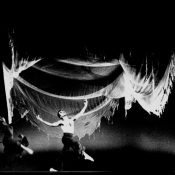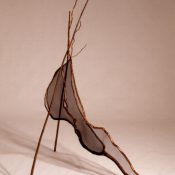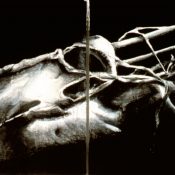Bio
Aiko Suzuki was a prolific and versatile artist whose work took the forms of textiles, acrylic and oil painting, or just painting, printmaking, installations, and even multimedia works and set design. She was also an art educator, curator, and a leader and mentor in the arts community: not the least of her achievements was the coordination of the 1994 print directory, Japanese Canadians in the Arts, which inspired this online directory.
Born in British Columbia, she was forcibly relocated as a child to the Slocan internment camp, and her family eventually resettled in London, Ontario. Aiko attended the London Artists’ Workshop, and in 1958 moved to Toronto and joined the Toronto Artists’ Workshop, soon becoming entwined in the local art scene.
As a textile artist, Aiko fought against the gendered stereotypes which ghettoized textiles as ‘craft’ rather than art. But she was also not bound to the borders of a single medium, creating work with a variety of materials and in a variety of settings.
Kerri Sakamoto describes how her ‘dramatic textile masterpiece, Lyra, became familiar sight to Torontonians in the front foyer of Toronto Public Library. Lyra was akin to a living drawing created with fibres instead of pencil strokes, hovering above a reflecting pool, offering visitors a moment’s calm amid a busy metropolis.’ Her ‘light and quick’ aesthetic sensibility emerged especially in ‘the stark, sweeping set designs for dance she created in the 1970s and 80s’.
It is also important to recognize the strength of Aiko’s vision beyond her own artwork: Sakamoto describes it as a desire to ‘forge connections between art, community and everyday life.’ She founded the Gendai Gallery*, a non-profit art space at the Japanese Canadian Cultural Centre in Toronto, in 1994. She championed artists from diverse communities, such as when she coordinated the exhibition Visions of Power: Contemporary Art by First Nations, Inuit and Japanese Canadians in 1991. She was generous in sharing her vision, her creativity, and her resources, both through her art and her organizing.
TAGS: Craft Visual Arts| Curating | installation | multimedia | painting | printmaking | textiles











